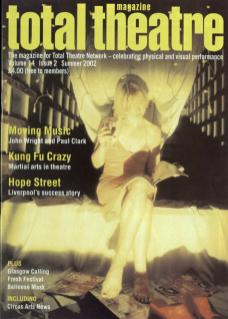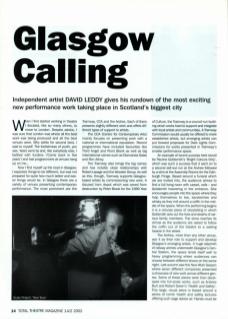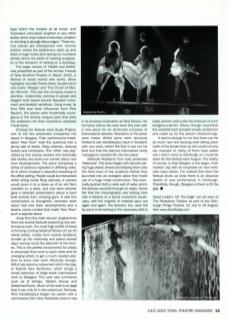When I first started working in theatre I decided, like so many others, to move to London. Despite advice, I was sure that London was where all the best work was being produced and all the best venues were. Why settle for second best, I said to myself. The foolishness of youth, you see. Years went by and, like everybody else, I battled with funders ('Come back in five years') and had programmers at venues hang up on me...
Now I find myself up the road in Glasgow. I expected things to be different, but was not prepared for quite how much better and easier things would be. In Glasgow there are a variety of venues presenting contemporary performance. The most prominent are the Tramway, CCA and the Arches. Each of them presents slightly different work and offers different types of support to artists.
The CCA (Centre for Contemporary Arts) mainly focuses on presenting work with a national or international reputation. Recent programmes have included favourites like Third Angel and Point Blank as well as big international names such as Diamanda Galas and Ron Athey.
The Tramway also brings the big names and has notably close relationships with Robert Lepage and the Wooster Group. As well as this, though, Tramway supports Glasgow-based artists by commissioning new work. A disused tram depot which was saved from destruction by Peter Brook for the 1990 Year of Culture, the Tramway is a council-run building which works hard to support and integrate with local artists and communities. A Tramway Commission would usually be offered to more established artists, but emerging artists can put forward proposals for Dark Lights Commissions for works presented in Tramway's smaller performance space.
An example of recent success here would be Pauline Goldsmith's Bright Colours Only, which was such a success that it went on to a second sell-out run at the Arches followed by a stint at the Assembly Rooms for the Edinburgh Fringe. Based around a funeral which we are invited into, the audience arrives to find a full living room with carpet, sofa – and Goldsmith hoovering in the entrance. She encourages people into the space where they help themselves to tea, sandwiches and whisky as they mill around a coffin in the middle of the space. When the performing begins it is a virtuoso piece of storytelling in which Goldsmith acts out the lives and deaths of various family members. The show reaches its climax as the audience are asked to follow the coffin out of the theatre to a waiting hearse in the street.
The Arches, more than any other venue, see it as their role to support and develop Glasgow's emerging artists. A huge labyrinth of railway arches underneath Glasgow's Central Station, the space lends itself well to heavy programming where audiences can choose between different shows on the same night. Last autumn saw the New Work Season where seven different companies presented a showcase of new work across different genres. Some of these pieces were then developed into full-scale works, such as Andrew Burt and Robert Green's Health and Safety. This large, visual piece is based around a series of comic health and safety lectures offering such sage advice as ‘Hands must be kept within the theatre at all times’ and 'Excessive convulsive laughter or any other action which may induce involuntary urination or vomiting is strongly discouraged'. These lecture pieces are interspersed with 'archive entries' where the performers dash up and down a huge murky arch acting out mundane stories about the perils of wearing sunglasses or the boredom of waiting on a doorstep.
The larger version of Health and Safety was presented as part of the Arches' Festival of New Scottish Theatre in March 2002, a festival of nearly twenty new works. Other highlights included Twelve Stars' double-bill of new works Morgan and The Church of Marilyn Monroe. This saw the company create a plaintive, melancholy evening of poised and elegant work based around repeated movement and skeletal narratives. Using music by Arvo Pärt and clear influences from Pina Bausch, the pieces were theatrically courageous in the drowsy, languid pace that drew the audience into their mysterious repeated movements.
Closing the festival were Scale Project, one of the few presented companies not based in Glasgow. Their performance-installation New Town took the audience into a dense pile of desks, filing cabinets, drawing boards and computers. This 'office' was populated by four bizarre workers who frantically told stories and acted out scenes about new town developments. The piece comprised a series of sections repeated in differing order, all of which involved a beautiful reworking of the office setting. People would be interviewed whilst sitting inside filing cabinets, a camera would zoom in to a close-up of an ant farm installed on a desk, and one town planner gave a detailed presentation about a town built entirely from chewing gum. It was this combination of thoughtful, resonant texts about real new town developments and a bizarre, comic context that made New Town such a popular piece.
Away from the main venues' programmes there are several festivals presenting new performance work. The most high-profile of these is the long-running National Review of Live Art where artists, mostly from outside Scotland, trundle up the motorway and spend several days running round the labyrinth of the Arches. This is the perfect environment for artists to showcase their work to each other and for emerging artists to get a much needed platform to show their work. Recently, though, NRLA has become subsumed within the larger festival New Territories, which brings a broad selection of large-scale international work to Glasgow. This year saw luminaries such as O Vertigo, Station House and Akademia Ruchu. Much of the work is so large that it can only fit in the cavernous Tramway. Wim Vandekeybus began his career with a commission from New Territories when it was in its previous incarnation as New Moves. His company Ultima Vez were back this year with a new piece for an all-female company of international dancers. Reactions to the piece were mixed. Whilst some were obviously thrilled to see Vandekeybus back in Scotland with new work, others felt that it was not his best and that the dancers themselves rarely managed to breathe life into the piece.
Materiali Resistenti from Italy presented Waterwall. The show began with dancers taking huge plastic sheets and draping them over the front rows of the audience before they launched into an energetic piece that made use of a huge metal construction. This eventually gushed forth a wide wall of water which the dancers could fly through on ropes. Some felt that the choreography was lacking here with a reliance on a banal movement vocabulary, with the majority of material spun out again and again. The dancers, too, were felt by some to be lacking in the necessary skill to really perform well under the pressure of such dangerous terrain. Others, though, found that the waterfall itself provided ample excitement and made up for the piece's shortcomings.
It seems strange to me that there can be so much new and exciting work taking place north of the border that my old London chums are unaware of. Many of them have asked why I didn't move to Edinburgh so I could be there for the festival each August. The reality, of course, is that Glasgow is the larger, more modern city with an emphasis on new work. Like many others, I've noticed that when the festival shuts up shop there is an absolute dearth of new performance in Edinburgh. Thankfully, though, Glasgow is there to fill the gap.
David Leddy's On The Edge can be seen at The Pleasance Theatre as part of the Edinburgh Fringe Festival, 31 July to 26 August See www.davidleddy.com


